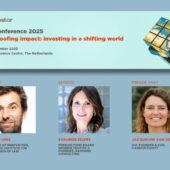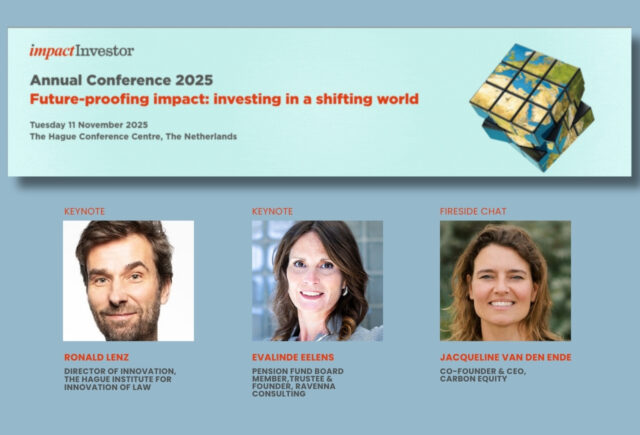Speaking at the Impact Investor Conference, guiding lights in the sector said a continent-wide push to bring more and larger institutions into the impact investing arena is needed if the sector is to realise its full potential as a force for good.

A more collaborative approach and wider measures to encourage the participation of pension funds and other large institutional investors are required if impact investment in Europe is to scale up faster, according to leading industry figures.
Speaking at the Impact Investor Conference 2024 in The Hague, those steering policy at national and pan-European bodies promoting impact investing agreed that a unified approach both within and between countries on the continent was urgently required.
Laure Wessemius-Chibrac, managing director of the Netherlands Advisory Board (NAB) on impact investing, said scaling up impact investing at the national level required collaboration at the European scale.
“If you want to influence policy, then finance is regulated at the European level, so it is very important for us when we do anything with ambition to influence policy in Europe, that we take it from a European perspective. We cannot do that by standing in isolation,” she said.
Brussels-based Impact Europe – formerly EVPA – is the industry body charged with coordinating efforts to raise the profile of impact investing in the European Commission and Parliament.
Jana Bour, the organisation’s head of policy and EU partnerships, told conference delegates that a coordinated approach to impact investing at the EU level was more likely to reap dividends.
“If you have five experts in front of you, and each of them have different idea, then you really don’t know what to decide. But if all of them have the same idea, then you can act on it,” she said.
To that end, Impact Europe launched an Impact Manifesto in April, ahead of June’s European elections, in conjunction with its partner organisations in the Netherlands, Belgium, Italy and Spain. The manifesto called on EU politicians and decision-makers to make impact central to EU policies, providing a wishlist of measures, including a call to make all EU public funding intentionally impactful. She said the manifesto remained a valuable tool for engagement with policymakers.
NAB is also participating in efforts to harmonise approaches to impact investment. Wessemius-Chibrac noted that one of its surveys had shown that, while most respondents said they had largely adopted the definition of impact investing devised by the Global Impact Investing Network (GIIN), the ways in which they applied it could vary significantly between organisations.
“The devil is definitely in the detail,” she said. “Part of our work with our colleagues in Europe has been to harmonise these definitions.”
The core characteristics of impact investing, as defined by the GIIN, are intentionality in providing measurable social or environmental benefit; the use of evidence and impact data in investment design; management of impact performance; and contributing to the growth of the industry.
Definitions pitfall
Steven Serneels, chair of Impact Finance Belgium (IFB), said he had mixed feelings about the sector becoming tied down by overly strict definitions of impact investment, if that prevented worthwhile investments from happening in the short term.
“I think sometimes it’s good to be ‘about right’. Definitions will change over time, the landscape is changing over time, but they should be ‘about right’,” he said, adding that “we should be serious about definitions, but not overly serious”.
Serneels said that the implementation of EU’s Corporate Sustainability Reporting Directive (CSRD) and other measures would help shape impact investing definitions in future.
A report published by IBF in October detailed how impact investing in Belgium – a market that used to be largely restricted to small-scale impact funds – would benefit by tapping institutional, retail, social investor and government resources, and should look towards successful initiatives in France, the Netherlands, the UK and elsewhere for inspiration.
Wessemius-Chibrac also emphasised the value of taking inspiration from successful cases of impact investment in other countries.
“We do not need to reinvent the wheel every time. What our colleagues from other countries have been doing, we try to make it known to our community in the Netherlands to accelerate the adoption of best practices or innovative instruments,” she said.
French inspiration
Panellists said France’s 90/10 model, which has unlocked a large amount of social investment is seen as point of reference for the rest of the continent, albeit subject to the restrictions of national investment frameworks.
Under the French model, companies with more than 50 employees are obliged by law to offer so-called 90/10 funds as part of their employee savings schemes. These funds are required to invest 5-10% of their assets into accredited ‘solidarity-based enterprises of social utility’. FAIR, France’s social investment association, reported earlier this year that savings in 90/10 funds reached €18bn in 2023. All life insurance product in France must also offer socially responsible, solidarity-based and green investment units.
Serneels said the French approach offered a blueprint for the rest of Europe as an example of scaling up impact funding, even if the way such measures could be applied would need to vary from country to country depending on the local environment.
Wessemius-Chibrac said that, while most European countries lack France’s enabling framework to drive institutional investments, such as pension funds and insurers into the impact arena, setting targets can still provide a valuable incentive to institutions keen to direct more funds into green and social impact investment.
Key role for targets
In 2022, NAB called for Dutch pension funds, asset managers, insurance companies and banks to allocate at least 10% of their assets under management (AUM) to impact investments by 2025. In a report published in September, NAB said that average allocation to impact-related investments had since increased, even if institutions needed to scale up faster.
Wessemius-Chibrac said that over the last three or four years, there had been an evolution in thinking among institutional investors, many of which had decided that impact investing should be part of their future strategy and now needed to decide how to best implement it.
“The goals are aspirational, but when you don’t have a goal within an organisation, it’s much more optional for the teams and the implementation side to do it. That’s why we have really advocated for the 10% target,” she said.
A number of Dutch-based institutional investors have already announced they are adopting the 10% target, with recent additions including a.s.r. and Achmea.
“These are very large organisations we’re talking about. They don’t make that kind of commitment if they don’t think they will achieve it. So, if they can do it, I think, why not everyone?” she said.





